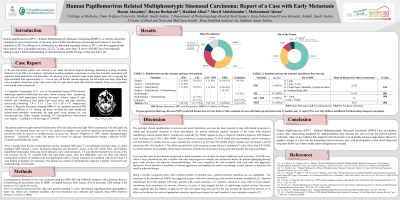Head and Neck Surgery
(239) Human Papilloma Virus Related Multiphenotypic Sinonasal Carcinoma; Case Report
Monday, October 2, 2023
2:45 PM - 3:45 PM East Coast USA Time

Has Audio

Sherif Abdelmonim, MS, PhD, FACS, FEBORL
Professor of otolaryngology, head and neck surgery
Ain Shams University
Cairo, Al Qahirah, Egypt- ma
mohamed aleissa, MD
king abdullah medical city - makkah, USA
Presenting Author(s)
Co-Author(s)
Disclosure(s):
Sherif Abdelmonim, MS, PhD, FACS, FEBORL: No relevant relationships to disclose.
Introduction: Human papillomavirus (HPV)-related multiphenotypic sinonasal carcinoma (HMSC), formerly known as HPV-related carcinoma with adenoid cystic carcinoma-like features, is a recently described neoplasm as a provisional entity in the most recent WHO classification of head and neck tumors, as a candidate to be a separate tumor entity, different from ACC and SCC.
It is the latest addition to the family of sinonasal tract carcinomas with an established etiological role of high-risk HPV types namely 16, 33, 35 and 56. It can also occur in the oral cavity, larynx, nasopharynx and sinonasal tract, with a paradoxical indolent clinical behavior
Methods: This is a case report study of a 50-year-old female patient complaining of painless right cheek swelling associated with epiphora, nasal
obstruction and rhinorrhea. By examination, CT and biopsy; a diagnosis was made. she was offered a right subtotal maxillectomy with SOH neck dissection with skin graft and right DCR.
Histopathology and immunophenotyping was done
Adjuvant concurrent chemo-radiation therapy was given
A comprehensive literature review was conducted using the MEDLINE and EMBASE databases leading to the inclusion of 12 articles for review
Data collection and analysis using SPSS Statistics Software
Results: 73 cases of HMSC were documented. The main presenting symptom was nasal obstruction (28%). 80.8% were treated surgically with adjuvant concurrent chemo-radiation therapy
Local recurrence occurred in 13 (17.8%) cases, distant metastasis was reported in 4 (5.5%) cases
Conclusions: Human Papilloma virus (HPV) - Related Multi phenotypic Sinonasal Carcinoma (HMSC) has an indolent course, thus, maximising treatment by multi modalities may increase the survival rate but doesn't prevent metastasis. There is no evidence that supports neck dissection even in locally advance stage tumor. However, negative margin is a key role for decreasing local recurrence rate, with post-operative close observation and long term follow up. Further study and investigation are needed.
